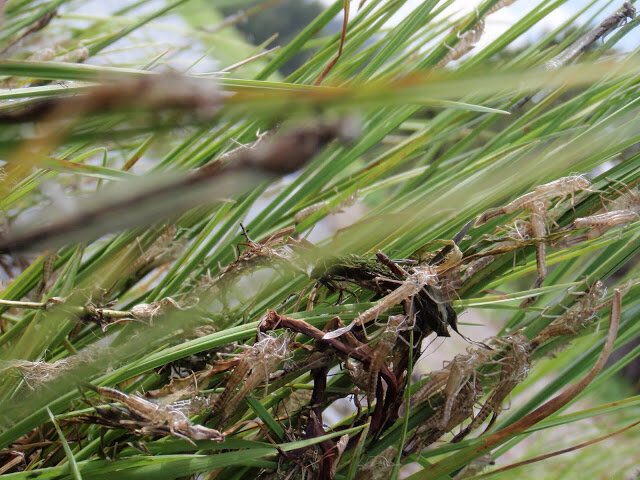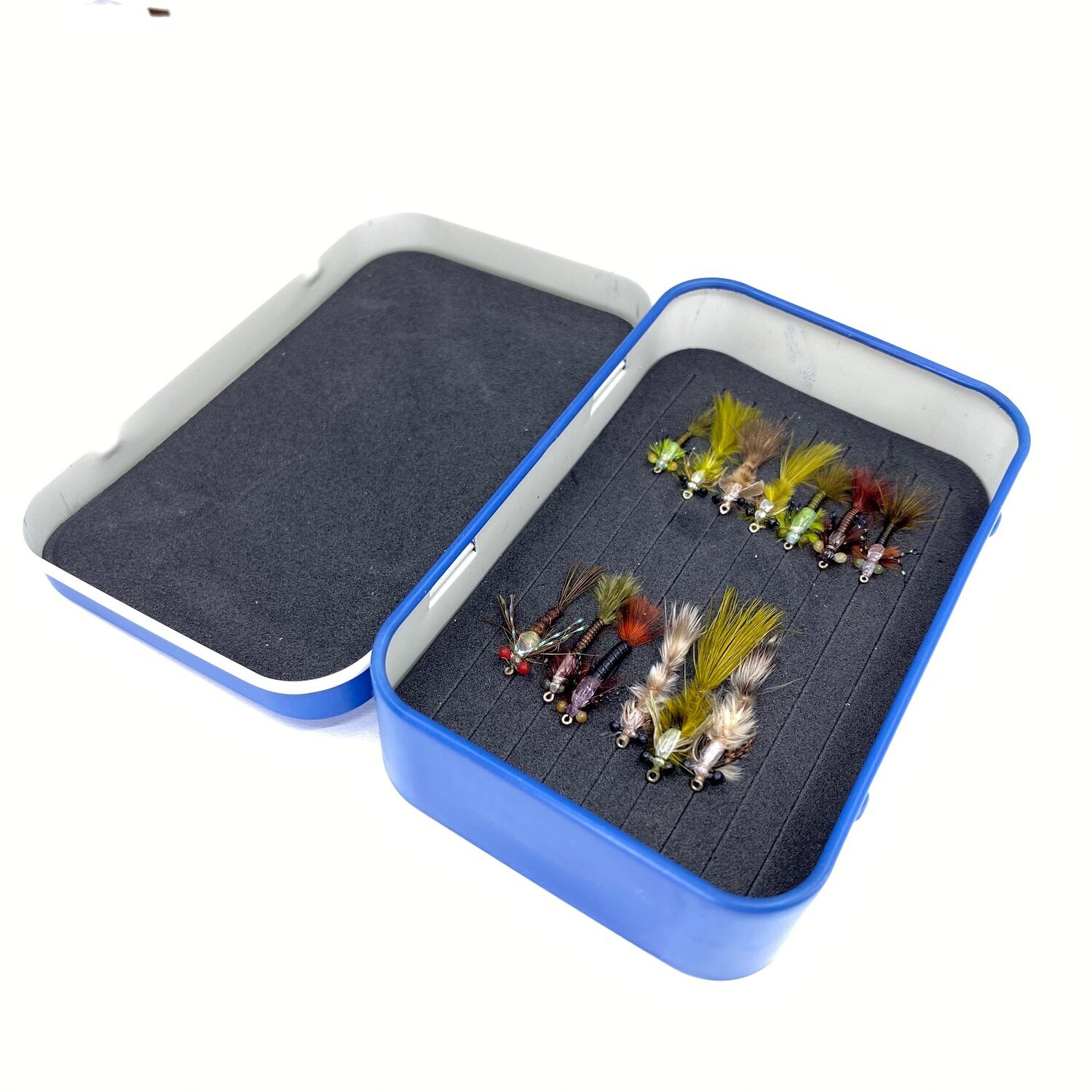If you fish in still water, whether it be for trout or panfish, damselflies are usually on the menu. With almost 3,000 species worldwide, chances are your home water has a few! Damselflies have a one to two-year lifecycle. They start life as aquatic insects, eventually transforming into winged adults. As nymphs, they do not transition through larva and pupa stages. A newly hatched damselfly nymph is just a smaller version itself; as they grow, they molt into a slightly larger form - a piece of information useful to the fly tier. Unlike an insect like a caddis fly that goes through larva and pupa transformations, a damselfly nymph always looks like a damselfly nymph! Once mature, the damselfly nymph swims towards shore and climbs on to bankside vegetation where it will split its skin along its wingcase and emerge as a winged adult.
The scores of empty damselfly nymph shucks on bankside vegetation is a good indication that a hatch is underway. Fish will be actively feeding on the nymphs as they swim towards shore!
Both the nymph and the adult are predacious, feeding on other insects like mosquitoes. Although damselflies and their larger cousins, the dragonflies look intimidating to some, they are harmless and quite beneficial as they eat other insects that are not so good to have around.
How many damselflies do you see in this photo? When you see something like this happening you better have both damselfly nymphs and adults in your fly box!
Fish relish both the nymph and adult forms of the insects, although they consume far more damselfly nymphs. Damselfly nymph patterns are one of my go-to nymph patterns for panfish, and I carry quite a few different designs with me on the water. One pattern that I have tied for years is the Hardbodied Damselfly Nymph. It has a realistic profile and is very durable, which is an essential characteristic of a panfish pattern. In the past, I have tied this pattern by dubbing the thorax and adding legs in a second step. The end result looks great, but it is a little time-consuming.
The original Hard Bodied Damselfly Nymph.
I am always on the lookout for ways to simplify fly patterns without reducing their effectiveness. In the case of the Straggle Damselfly Nymph, I replaced the dubbing and crystal flash legs that I usually add to the HardBodied Damselfly Nymph with a thorax of Semperfli Ice Straggle Chenille, and I love the result!
Straggle string has shortest fibers perfect for smaller flies!
Straggle chenille is not a new product. Straggle Legs and Straggle String are similar products that are great for adding legs on both your nymphs and your dry flies. Last year Semperfli introduced Ice Straggle chenille.
Straggle ice chenille has a mix of both natural and fluorescent highly mobile fibers that provide a lot of action. The fibers' length is perfect for larger damselfly patterns (8-10). I prefer to use straggle legs or straggle string for smaller versions.
Chicone’s Stealth Chain is a matt finish bead chain available in a variety of colors.
I often tie this pattern with mono eyes, but I substituted the mono eyes with bead-chain on flies where I want to add a little extra weight. The matt finish Chicone's Stealth Chain eyes look fantastic on this pattern, although any standard bead-chain will work.
Black wire wrapped between the tubing clearly defines the body segments.
There are a lot of different choices for the body material on this fly. I used a stretch tubing I found in a craft store used for making bracelets, but any vinyl ribbing type product will work here. Don't have any? Make a dubbed body! If you look closely, you can see a precise segmentation on this pattern. That is achieved by wrapping a contrasting colored wire (in this case, black) through the segments after creating the body. Admittedly it may be more for the fisherman than the fish, but it adds a nice effect.
You can create a quick and easy body on your damselfly nymphs by wrapping the feather used for the tail around the hook shank. It is a good idea to reinforce it with a wire rib.
For the tail, I used some olive dyed Grizzly Chickabou, but you can substitute standard marabou if desired. Use a solid color if you don't have a variegated color. I often eliminate the vinyl tubing and wrap the feather used for the tail for a quick, down and dirty body. Since these feathers are delicate, I always counter wrap with wire to add a little durability to the fly.
The wing case on this fly is Swiss Straw, but I will often use scud back, thin skin, or other synthetic materials. I happened to have a few scraps of swiss straw lying on my desk when I started tying these up, so that's what I went with. Since swiss straw can be a little delicate so it received a coat of Solarez UV Resin to protect it.
The concept of swapping out materials will be covered in-depth in a future Fly Tying Friday segment, but I wanted to touch on it here. Too many fly tiers get hung up on using the EXACT materials specified in a recipe. They will search the ends of the earth to find an item listed in a pattern recipe. In fly tying, you have many opportunities to swap one material out for another and still create a fishable fly. In some cases, these experiments have produced flies even more effective than the original pattern. So don't be afraid to experiment if you don't have the same materials. As always, if you do want to find those materials listed in this pattern, you can find most of them here!
Pattern Recipe:
Hook: Natural bend nymph hook (sizes 8-14 - size 8 shown))
Thread: Semperfli 6/0 Waxed Thread (pale olive used in this example)
Tail: Grizzly Chickabou in color of choice (olive used here)
Body: Vinyl stretch tubing from a craft store
Ribbing: Contrasting colored wire (black fine used here)
Thorax: Semperfli Straggle Ice Chenille, Straggle Legs or Straggle String
Wingcase: Swiss straw
Eyes: Chicone’s Stealth Chain (medium olive grass shown here)
What I did not realize while tying this fly was that the body material had UV properties. You can see the glow on the photo on the right when I applied a UV light to cure the resin used on the wing case.











